 By Bob Currie, Recreational Boating Safety Specialist
By Bob Currie, Recreational Boating Safety Specialist
U. S. Coast Guard Auxiliary Station Galveston Flotilla
What would you think if, while driving down the highway, you were pulled over by the Texas Highway Patrol, and instead of asking you for your license and registration the trooper instead asked for permission to climb into your vehicle? That would really be something, but that is basically how it works on the water. On the water you will hear the same siren and see the same lights as you would when stopped in your car, but the difference is you will actually be boarded by one or two Coast Guard Law Enforcement Officers. This column will address what you can expect from the experience and help you prepare for a possible boarding from the Coast Guard.
The Base Galveston Flotilla of the US Coast Guard Auxiliary operates out of the US Coast Guard base on Galveston Island. They aid the Coast Guard by providing maritime observation patrols in Galveston Bay; by providing recreational boating vessel safety checks; and by working alongside Coast Guard members in maritime accident investigation, small boat training, providing a safety zone, Aids to Navigation verification, cooking in base and station galleys and aboard cutters, and on the Coast Guard Drone Team.
Who Are We, Who Who, Who Who?
The song by The Who goes a little bit differently, but the question is the same. The answer is Coast Guard boarding teams are highly trained in maritime law enforcement and are looking for boaters who have the proper safety equipment. You will be pulled over to the side of a wave and the Coast Guard Small Boat will approach your vessel close enough for the boarding team to enter your boat. The Coast Guard Small Boat will consist of the coxswain, who is in charge and is more often than not operating the boat, the boat crew members, and the boarding team. The boarding team will be easy to spot. They will be sporting side arms and will be wearing bullet proof vests.
Occasionally boarding teams will be carried by Coast Guard Auxiliary boat. Boats, planes, helicopters, and vehicles that meet Coast Guard standards and pass an inspection are called Operational Facilities (OPFACS). Some Auxiliarists outfit their boats to Coast Guard standards and have them inspected and certified as OPFACS. Although they are primarily used for Coast Guard Auxiliary missions, they can be used for missions in which active duty Coast Guard personnel are aboard and under orders. You will most often find the Auxiliary OPFAC being used for law enforcement in shallow bays that can’t be navigated by regular Coast Guard small boats.
When, Where, and Why
The Coast Guard has the authority under Title 14 USC 89 to make inquiries, examinations, inspections, searches, seizures, and arrests upon the high seas and waters over which the United States has jurisdiction, in order to enforce federal laws. The Coast Guard can inspect any craft at any time in their jurisdiction. Coast Guard boarding officers enforce federal laws and regulations. Avoiding a citation is relatively easy: obey the rules of navigation, ensure your boat is properly registered and marked, and keep and maintain all required safety equipment. The primary reason for boarding is to make a safety check. It is a myth that the Coast Guard must have probable cause to board your vessel. The Coast Guard can board you at any time.
Pre-Boarding Observations
Before the Coast Guard hits the lights and siren, they have already made some basic observations and assumptions. They can see if the boat numbers are properly displayed on the side of the hull, they know who is and who is not wearing a life jacket, they know whether the passengers are properly seated and not illegally sitting on the gunwale or bow, and they can tell when someone is obviously operating impaired, recklessly, or in violation of the Rules of the Road.
Preparing to be Boarded
When you see the flashing blue lights and here the siren, stop your boat immediately. If your location is not convenient for boarding, the Coast Guard boarding team will ask you to move to a better spot for boarding. Once you have stopped where you have been told to stop, do two things:
1. Kill your engine but leave your kill switch lanyard attached.
2. Tell everyone on board to remain seated.
There is no need to start gathering items for the Law Enforcement Officers (LEO) to examine. Just follow their instructions as they give them to you. You will be asked if there are any weapons aboard. Answer the question verbally; do not reach for a weapon to show it. Depending on the size of your boat, one to four LEOs will board your boat. You do not have to do any maneuvering; the coxswain will gently bring the Coast Guard boat alongside your boat. Remember- turn your engine off.
What Are They Looking For?
Although the boarding team could perform a full Vessel Safety Check, most of the time they are looking for the five biggies:
1. Registration numbers and certificate
2. Life jackets and throw cushion
3. Sound-producing device
4. Fire extinguisher
5. Visual distress signals
Often the boarding and inspection happens so quickly that you don’t lose any time. Let’s look at the five biggies a little closer.
Registration Number and Certificate
The boat registration number must be permanently attached to each side of the forward half of the boat. Characters must be plain, vertical block style, not less than three inches high, and in a color contrasting with the background. A space or hyphen must separate the letters from the numbers. State law will define where the state registration sticker goes, but boat registered in Texas must have the state registration sticker attached aft (to the rear) of the numbers. Registration or documentation papers must be on board and available. See the sample State of Texas Certificate of Number for a Vessel.
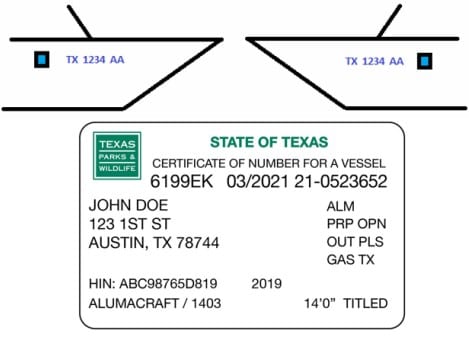
Life Jacket and Throw Cushion
Acceptable life jackets must be U.S. Coast Guard approved and in good, serviceable condition. A wearable life jacket of suitable size is required for each person on the boat. Children must have properly fitted life jackets designed for children. Wearable life jackets shall be “readily accessible.” Boats/rowboats 16 feet or longer (except canoes and kayaks) must have one type IV (throwable) device, which shall be “immediately available” (not stowed).

Life jackets shall NOT be stored in unopened plastic packaging. For Personal Watercraft riders, the life jacket must be worn. An impact rating is recommended but not required. Speaking with experience, I highly recommend an impact-rated life jacket.
Sound Producing Devices
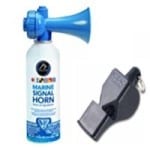 To comply with Navigation Rules and for distress signaling purposes all boats must carry a sound producing device (whistle, horn, siren, etc.) capable of a 4-second blast audible for at least half a mile. The Fox 40 pea-less whistle, developed for referees, is a popular option for kayakers, PWC operators, and produces quite a loud signal. I recommend that you have one attached to your PFD. That way if you end up in the water you have a readily available signaling device. The marine signal horn shown is a popular option for larger vessels. If you use that as your signaling device, I recommend that you also have a backup whistle on board as well.
To comply with Navigation Rules and for distress signaling purposes all boats must carry a sound producing device (whistle, horn, siren, etc.) capable of a 4-second blast audible for at least half a mile. The Fox 40 pea-less whistle, developed for referees, is a popular option for kayakers, PWC operators, and produces quite a loud signal. I recommend that you have one attached to your PFD. That way if you end up in the water you have a readily available signaling device. The marine signal horn shown is a popular option for larger vessels. If you use that as your signaling device, I recommend that you also have a backup whistle on board as well.
Fire Extinguisher
Fire extinguishers are required if one of the following conditions exist: (1) Inboard engine, (2) double bottom hulls not completely sealed or filled with flotation materials, (3) closed living space, (4) Closed stowage compartments that contain flammable materials, or (5) permanently installed fuel tanks. Fire extinguishers must be readily accessible and verified as serviceable. The requirements according to length are:
| BOAT LENGTH | WITHOUT FIXED SYSTEM | WITH FIXED SYSTEM |
| Under 26 feet | 1 extinguisher, type B-I | None |
| 26 feet to 40 feet | 2 B-I or 1 B-II | 1 B-I |
| 40 feet to 65 feet | 3 B-I or 1 B-II and 1 B-I | 2 B-I or 1 B-II |
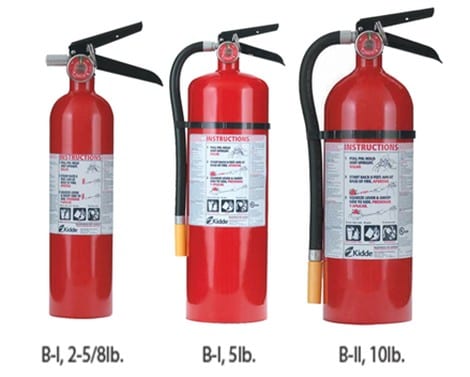
Visual Distress Signals
Recreational boats 16 feet and longer used on coastal waters or Great Lakes are required to carry a minimum of either (1) three day and three night pyrotechnic devices, 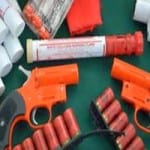 (2) one day non-pyrotechnic device (flag) and one night non-pyrotechnic device (auto SOS light), or (3) a combination of (1) and (2). Recreational boats less than 16 feet on coastal waters or the Great Lakes need only carry night visual distress signals when operating from sunset to sunrise. It is recommended but not required that boats operating on inland waters should have some means of signaling a suitable day and night distress signal. Note that Trinity Bay, Galveston East Bay, and Galveston West Bay are considered coastal waters.
(2) one day non-pyrotechnic device (flag) and one night non-pyrotechnic device (auto SOS light), or (3) a combination of (1) and (2). Recreational boats less than 16 feet on coastal waters or the Great Lakes need only carry night visual distress signals when operating from sunset to sunrise. It is recommended but not required that boats operating on inland waters should have some means of signaling a suitable day and night distress signal. Note that Trinity Bay, Galveston East Bay, and Galveston West Bay are considered coastal waters.
Reducing Your Chance of Being Boarded
A Coast Guard Vessel Safety Check decal displayed on the port side of the boat indicates that the boat has undergone 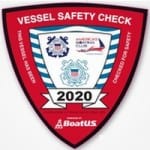 a Coast Guard Vessel Safety Check for the year indicated on the decal. Although some people think of this as a means of being excused from being boarded, that isn’t so. It does let the boarding team know that the boat has been inspected and most likely the boat meets all regulations. This can certainly lead to a quicker boarding process and appreciation from the boarding team. They really want to find safe boaters.
a Coast Guard Vessel Safety Check for the year indicated on the decal. Although some people think of this as a means of being excused from being boarded, that isn’t so. It does let the boarding team know that the boat has been inspected and most likely the boat meets all regulations. This can certainly lead to a quicker boarding process and appreciation from the boarding team. They really want to find safe boaters.
Texas, Our Texas! All Hail the Mighty State!
Many states, including Texas, have boating safety requirements above and beyond those of the Coast Guard. Coast Guard boarding teams have the authority to enforce state laws in regard to safe boating. 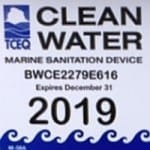 With this in mind, remember that when operating boats equipped with an emergency kill switch you must have the kill switch lanyard attached to your person when underway at greater than headway speed (idle). Also, if you have an installed toilet aboard with a holding tank (marine sanitation device), you must have it registered with the Texas Commission on Environmental Quality (TCEQ) and display a TCEQ sticker on both sides aft of the Texas registration certificate, and the drain pipe must be blocked closed unless you are outside the zone where waste cannot be dumped.
With this in mind, remember that when operating boats equipped with an emergency kill switch you must have the kill switch lanyard attached to your person when underway at greater than headway speed (idle). Also, if you have an installed toilet aboard with a holding tank (marine sanitation device), you must have it registered with the Texas Commission on Environmental Quality (TCEQ) and display a TCEQ sticker on both sides aft of the Texas registration certificate, and the drain pipe must be blocked closed unless you are outside the zone where waste cannot be dumped.
Summary
If you understand what boarding by a Coast Guard boarding team is all about and follow all the safety regulations, a boarding can be a pleasant and interesting experience. The teams are doing their job to help you have a safe boating experience. You won’t meet a nicer bunch of professionals.
For more information on boating safety, please visit the Official Website of the U.S. Coast Guard’s Boating Safety Division at www.uscgboating.org. Questions about the US Coast Guard Auxiliary or our free Vessel Safety Check program may be directed to me at [email protected]. I am available to perform free Vessel Safety Checks, and I will come to your location to perform them. SAFE BOATING!
[Dec-21-2020]

 Posted in
Posted in 
























